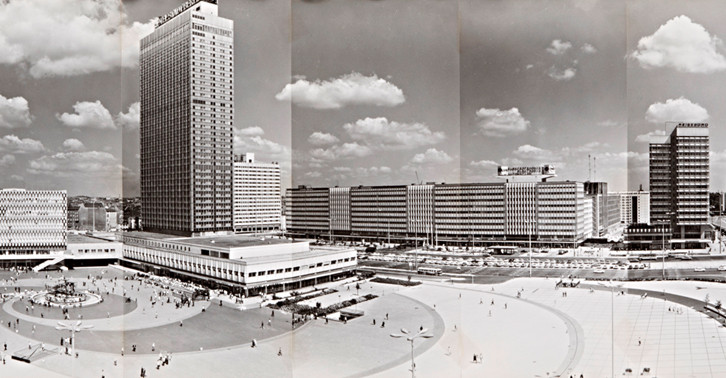Radically Modern
29 May - 26 Oct 2015

Heinz Lieber
Panorama Alexanderplatz, Fotografie, 1972
© Rechtsnachfolger Heinz Lieber, Repro: Kai-Annett Becker
Panorama Alexanderplatz, Fotografie, 1972
© Rechtsnachfolger Heinz Lieber, Repro: Kai-Annett Becker
RADICALLY MODERN
Urban Planning and Architecture In 1960s Berlin
29 May – 26 October 2015
Architecture and urban design from the sixties still set their stamp on the Berlin townscape. Many key planning decisions were made in the sixties and some striking buildings were constructed during that period. The Berlinische Galerie presents the first ever comprehensive overview of this architectural heritage in both East and West Berlin. Historical documents, some familiar and others of more recent origin, illustrate political, social and technical visions for developing a city that had suffered severe destruction in previous decades and was then divided by the Wall. Alongside themes such as the objectives, common denominators and distinguishing factors that define a selection of these developments, such as Stalinallee, Alexanderplatz, Breitscheidplatz and the Märkisches Viertel, the exhibition explores features of these architectural designs that reveal international networking between those involved or else illustrate how knowledge of international trends was reflected in concrete designs. About 300 works by some 30 architects, planning partnerships, photographers and artists are on display.
Architects (selected): Werner Düttmann, Fehling + Gogel, Walter Gropius, Georg Heinrichs, Josef Kaiser, Roland Korn, Ludwig Leo, Ludwig Mies van der Rohe, Klaus Müller-Rehm, Ulrich Müther, Hans Scharoun, Manfred Zumpe
Artists (selected): Beate Gütschow, Karsten Konrad, Hendrik Krawen, Bernd Trasberger, Stephen Willats
Exhibition Architecture: david saik studio
Catalogue
The fully-illustrated exhibition catalogue published by Wasmuth Verlag in German and English editions includes texts by Bruno Flierl, Hartmut Frank, Anna Heckmann, Irma Leinauer, Ursula Müller, Frank Seehausen, Dirk Weilemann, Adrian von Buttlar and Stanislaus von Moos. The exhibition and catalogue are made possible by the Kulturstiftung des Bundes. The catalogue is additionally funded by the Wüstenrot Foundation.
Urban Planning and Architecture In 1960s Berlin
29 May – 26 October 2015
Architecture and urban design from the sixties still set their stamp on the Berlin townscape. Many key planning decisions were made in the sixties and some striking buildings were constructed during that period. The Berlinische Galerie presents the first ever comprehensive overview of this architectural heritage in both East and West Berlin. Historical documents, some familiar and others of more recent origin, illustrate political, social and technical visions for developing a city that had suffered severe destruction in previous decades and was then divided by the Wall. Alongside themes such as the objectives, common denominators and distinguishing factors that define a selection of these developments, such as Stalinallee, Alexanderplatz, Breitscheidplatz and the Märkisches Viertel, the exhibition explores features of these architectural designs that reveal international networking between those involved or else illustrate how knowledge of international trends was reflected in concrete designs. About 300 works by some 30 architects, planning partnerships, photographers and artists are on display.
Architects (selected): Werner Düttmann, Fehling + Gogel, Walter Gropius, Georg Heinrichs, Josef Kaiser, Roland Korn, Ludwig Leo, Ludwig Mies van der Rohe, Klaus Müller-Rehm, Ulrich Müther, Hans Scharoun, Manfred Zumpe
Artists (selected): Beate Gütschow, Karsten Konrad, Hendrik Krawen, Bernd Trasberger, Stephen Willats
Exhibition Architecture: david saik studio
Catalogue
The fully-illustrated exhibition catalogue published by Wasmuth Verlag in German and English editions includes texts by Bruno Flierl, Hartmut Frank, Anna Heckmann, Irma Leinauer, Ursula Müller, Frank Seehausen, Dirk Weilemann, Adrian von Buttlar and Stanislaus von Moos. The exhibition and catalogue are made possible by the Kulturstiftung des Bundes. The catalogue is additionally funded by the Wüstenrot Foundation.
